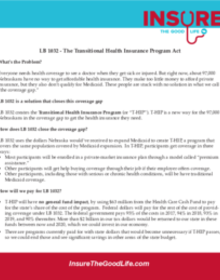Policy
LB 1032 - The Transitional Health Insurance Program Act
What’s the problem?
Everyone needs health coverage to see a doctor when they get sick or injured. But right now, about 97,000 Nebraskans have no way to get affordable health insurance. They make too little money to afford private insurance, but they also don’t qualify for Medicaid. These people are stuck with no solution in what we call “the coverage gap.”
LB 1032 is a solution that closes this coverage gap
LB 1032 creates the Transitional Health Insurance Program (or “T-HIP”). T-HIP is a new way for the 97,000 Nebraskans in the coverage gap to get the health insurance they need.
How does LB 1032 close the coverage gap?
LB 1032 uses the dollars Nebraska would’ve received to expand Medicaid to create T-HIP, a program that covers the same population covered by Medicaid expansion. In T-HIP, participants get coverage in three ways:
- Most participants will be enrolled in a private-market insurance plan through a model called “premium assistance.”
- Other participants will get help buying coverage through their job if their employer offers coverage.
- Other participants, including those with serious or chronic health conditions, will be have traditional Medicaid coverage.
How will we pay for LB 1032?
- T-HIP will have no general fund impact, by using $63 million from the Health Care Cash Fund to pay for the state’s share of the cost of the program. Federal dollars will pay for the rest of the cost of providing coverage under LB 1032. The federal government pays 95 percent of the costs in 2017, 94 percent in 2018, 93 percent in 2019, and 90 percent thereafter. More than $2 billion in our tax dollars would be returned to our state in these funds between now and 2020, which we could invest in our economy.
- There are programs currently paid for with state dollars that would become unnecessary if T-HIP passes, so we could end those and see significant savings in other areas of the state budget.
Does LB 1032 require participants to contribute to the cost of their care?
- Yes. Under T-HIP, most participants must contribute 2 percent of their monthly household income as a premium. They can’t lose coverage if they don’t pay, but the unpaid premiums are a collectable state debt. This ensures everyone pays a cost of their own insurance.
- There is a $50 co-payment for using the emergency room in a non-emergency situation.
- Participants do not have to pay deductibles or other cost sharing on the private plans.
How does LB 1032 help people be healthier?
- When people have health coverage, they can get the preventive health care they need and not have to wait until they get very sick just to see a doctor. Under T-HIP, all participants will be able to see to a primary care provider, which means they can get ongoing preventive care from their regular doctor.
- T-HIP also includes innovative health care practices that have been proven to work in other states in helping people get better care—like patient-centered medical homes.
How will passing LB 1032 benefit our state’s economy?
- LB 1032 would have a significant positive impact on Nebraska’s economy. It would allow Nebraska to bring back around $2 billion in our tax dollars to our state between now and 2020 to pay for coverage and boost our economy.
- Between now and 2020, a program like T-HIP would generate almost $175 million in Nebraska state revenue and support an estimated 10,000 jobs.
How does LB 1032 encourage employment and education and skills training?
- • Part of LB 1032 helps participants get information about education and training programs to help them advance in their careers if they’re looking for a new job.
- • LB 1032 also creates a program that provides education and training for enrollees to get the skills they would need to fill jobs that are in-demand in Nebraska.


